"House of Horrors" (20 photos)
 Bashny.Net
Bashny.Net
It is a small neat house in Kristiansade next to the road in the port of Stavanger, and during the war was the most horrible place throughout the south of Norway. «Skrekkens hus» - «House of terror" - so named it in the city. Since January 1942, the city archives building was the headquarters of the Gestapo in southern Norway.
These prisoners were brought here were equipped torture chambers, hence the people sent to concentration camps and the firing squad.
Who is in the basement of the building where the punishment cells were located and where prisoners were tortured, a museum, telling about what happened during the war in the building of State Archives.
Disposition of the basement corridors left unchanged. There were only new lights and doors. In the main corridor of the main exhibition is arranged with archival materials, photographs, posters.
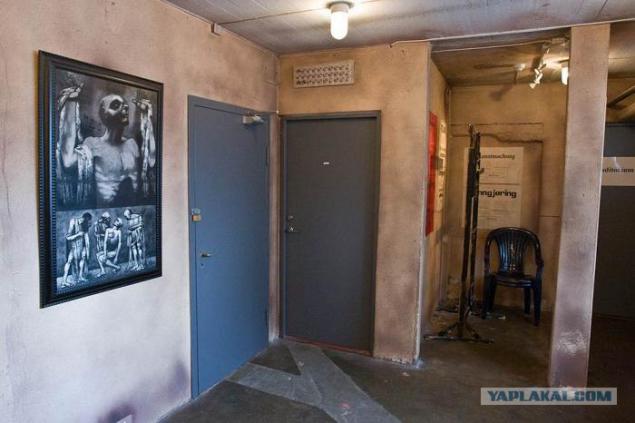
So suspended beaten arrested chain.

So tortured with electric stoves. With particular zeal of the executioners could ignite a human hair on the head.
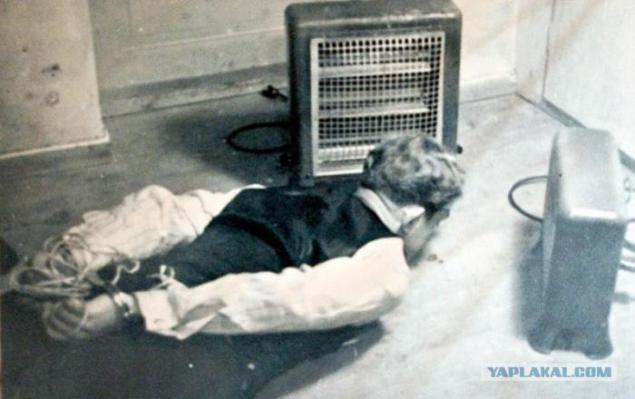
Water torture

In this device, finger crimp pulled out nails.
The machine authentic - after the city's liberation from the Germans all the equipment torture chambers remained in place and was saved.
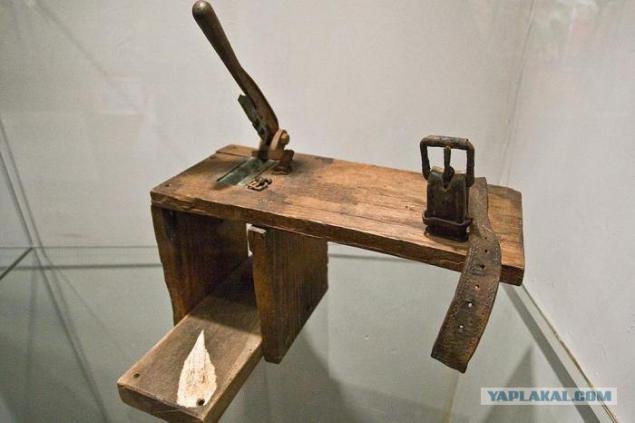
Next - other devices for interrogation with "addiction."
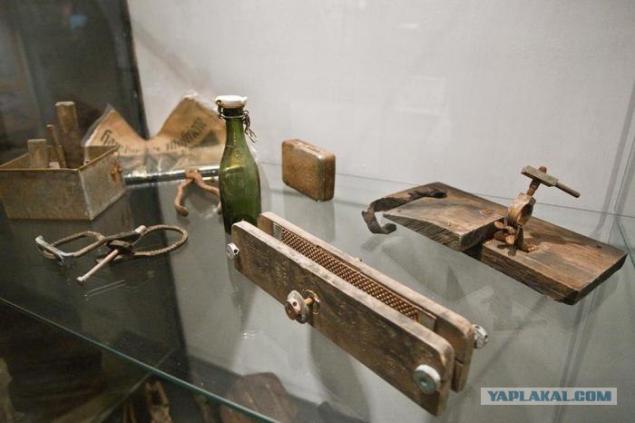
Several basements are arranged reconstruction - as it looked then, in this very spot. This camera, which contained extremely dangerous detainees - trapped in the clutches of the Gestapo member of the Norwegian Resistance.

In the next room was located a torture chamber. It reproduced the actual scene of torture couples underground, taken by the Gestapo in 1943, during the session with the intelligence center in London. Two Gestapo tortured his wife in front of her husband.
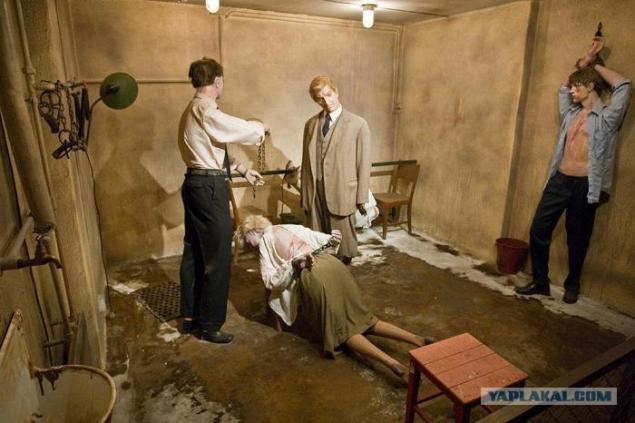
In all cell left, as if a 43-m. If you turn the pink stool, standing at the feet of the women, you can see the mark of the Gestapo Kristiansand.

Reconstruction of interrogation - Gestapo agent provocateur (left) presents arrested clandestine radio operator group (it sits right in handcuffs) his radio in a suitcase. In the center sits kristiansandskogo chief of the Gestapo, SS-Hauptsturmführer Rudolf Kern.

In this showcase items and documents of the Norwegian patriots, which is sent to a concentration camp near Oslo Greene - Chief forwarding station in Norway, where the prisoners were sent to other concentration camps in Europe.

Notation of different groups of prisoners in the Auschwitz concentration camp (Auschwitz-Birkenau). The Jew, the political, the Roma, the Spanish Republican, a dangerous criminal, a criminal, a war criminal, a Jehovah's Witness, homosexual. An example of the icon of the Norwegian watered-prisoner.

The museum lead school ekskursii.neskolko local teenagers walked the corridors together with the Tour Robstadom, volunteers from local residents who survived the war. They say that in the year in the Archives of the museum is visited by about 10,000 students.

Toure told the guys about Auschwitz. Two boys from the group had been there recently on a tour.
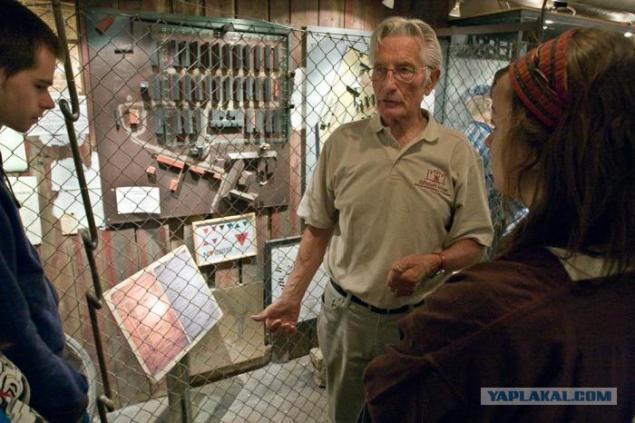
Soviet prisoners of war in a concentration camp. In his hand - a home-made wooden bird.
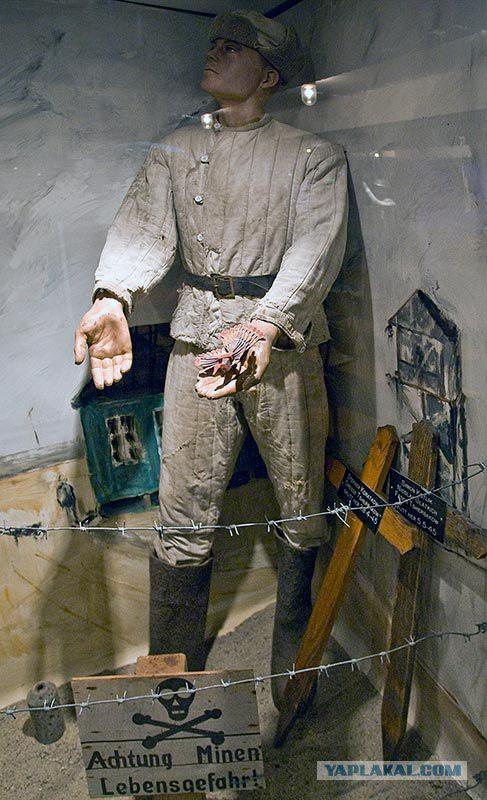
In a separate showcase things made by hands of Russian prisoners of war in the Norwegian camps. These crafts Russian bartered for food from the locals.
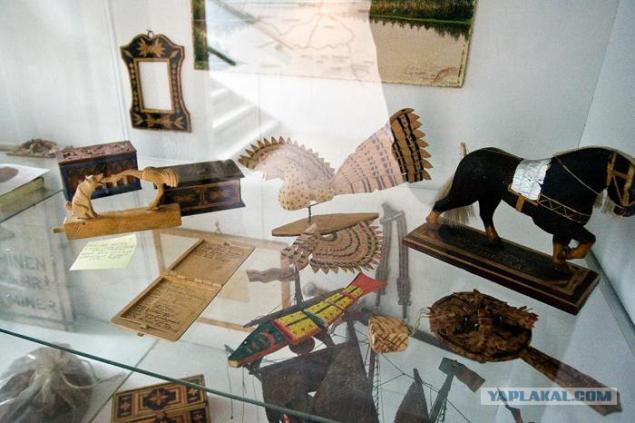
Reconstruction of guerrilla radio. Guerrillas in southern Norway to London passed information about German troop movements, deployment of military equipment and vehicles. In the north of the Norwegian intelligence supplied the Soviet Northern Navy.
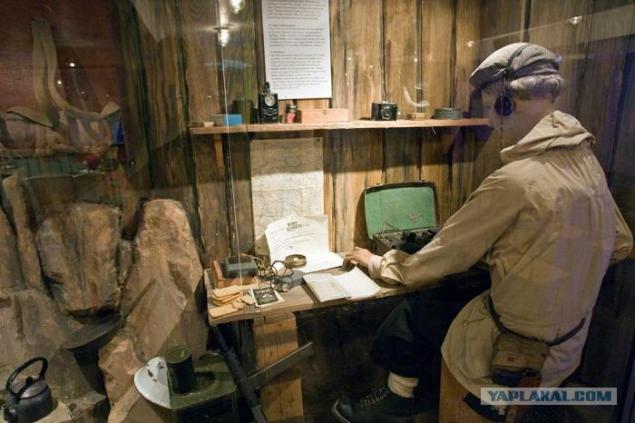
Rudolf Kerner - kristiansandskogo Gestapo chief. A former teacher of shoemaking. Notorious sadist in Germany had a criminal past. I went to camp a few hundred members of the Norwegian Resistance.

The promotion of a "new Norwegian" strongly emphasizes the relationship of the two "Nordic" peoples, their solidarity in the struggle against British imperialism and "wild Bolshevik hordes".
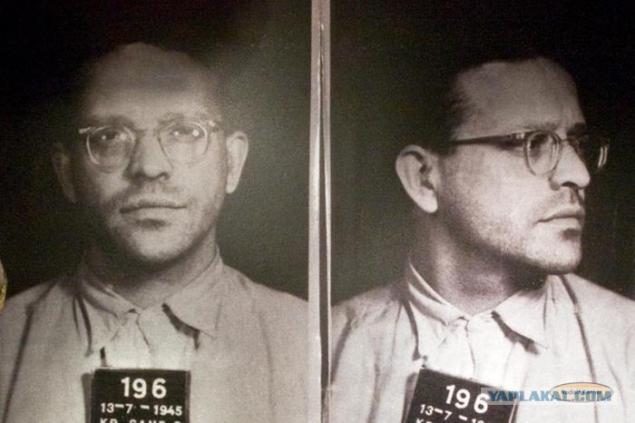
Next to the archive building is a modest monument to those killed at the hands of the Gestapo Norwegian patriots. At the local cemetery, napodaleku from this place, lie the remains of Soviet prisoners of war, and British pilots shot down by the Germans in the skies over Kristiansand
via newsland

Source:
These prisoners were brought here were equipped torture chambers, hence the people sent to concentration camps and the firing squad.
Who is in the basement of the building where the punishment cells were located and where prisoners were tortured, a museum, telling about what happened during the war in the building of State Archives.
Disposition of the basement corridors left unchanged. There were only new lights and doors. In the main corridor of the main exhibition is arranged with archival materials, photographs, posters.

So suspended beaten arrested chain.

So tortured with electric stoves. With particular zeal of the executioners could ignite a human hair on the head.

Water torture

In this device, finger crimp pulled out nails.
The machine authentic - after the city's liberation from the Germans all the equipment torture chambers remained in place and was saved.

Next - other devices for interrogation with "addiction."

Several basements are arranged reconstruction - as it looked then, in this very spot. This camera, which contained extremely dangerous detainees - trapped in the clutches of the Gestapo member of the Norwegian Resistance.

In the next room was located a torture chamber. It reproduced the actual scene of torture couples underground, taken by the Gestapo in 1943, during the session with the intelligence center in London. Two Gestapo tortured his wife in front of her husband.

In all cell left, as if a 43-m. If you turn the pink stool, standing at the feet of the women, you can see the mark of the Gestapo Kristiansand.

Reconstruction of interrogation - Gestapo agent provocateur (left) presents arrested clandestine radio operator group (it sits right in handcuffs) his radio in a suitcase. In the center sits kristiansandskogo chief of the Gestapo, SS-Hauptsturmführer Rudolf Kern.

In this showcase items and documents of the Norwegian patriots, which is sent to a concentration camp near Oslo Greene - Chief forwarding station in Norway, where the prisoners were sent to other concentration camps in Europe.

Notation of different groups of prisoners in the Auschwitz concentration camp (Auschwitz-Birkenau). The Jew, the political, the Roma, the Spanish Republican, a dangerous criminal, a criminal, a war criminal, a Jehovah's Witness, homosexual. An example of the icon of the Norwegian watered-prisoner.

The museum lead school ekskursii.neskolko local teenagers walked the corridors together with the Tour Robstadom, volunteers from local residents who survived the war. They say that in the year in the Archives of the museum is visited by about 10,000 students.

Toure told the guys about Auschwitz. Two boys from the group had been there recently on a tour.

Soviet prisoners of war in a concentration camp. In his hand - a home-made wooden bird.

In a separate showcase things made by hands of Russian prisoners of war in the Norwegian camps. These crafts Russian bartered for food from the locals.

Reconstruction of guerrilla radio. Guerrillas in southern Norway to London passed information about German troop movements, deployment of military equipment and vehicles. In the north of the Norwegian intelligence supplied the Soviet Northern Navy.

Rudolf Kerner - kristiansandskogo Gestapo chief. A former teacher of shoemaking. Notorious sadist in Germany had a criminal past. I went to camp a few hundred members of the Norwegian Resistance.

The promotion of a "new Norwegian" strongly emphasizes the relationship of the two "Nordic" peoples, their solidarity in the struggle against British imperialism and "wild Bolshevik hordes".

Next to the archive building is a modest monument to those killed at the hands of the Gestapo Norwegian patriots. At the local cemetery, napodaleku from this place, lie the remains of Soviet prisoners of war, and British pilots shot down by the Germans in the skies over Kristiansand
via newsland

Source:
Tags
See also
The reaction of the people in the house of horrors (47 photos)
The torture of the Gestapo (25 photos)
Frightened people in the house of horrors
Bay of forgotten ships
On the seas, on the waves: the most amazing house on the water
Died last passenger of "Titanic"
Care and maintenance of the puppy Alabai
The worst place on earth: where to go on Halloween
Scientists have made a new map of the worst places on Earth

















